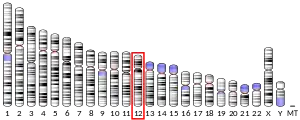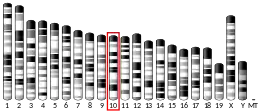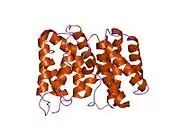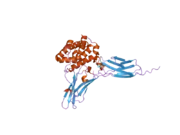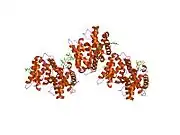| IL22 | |||||||||||||||||||||||||||||||||||||||||||||||||||
|---|---|---|---|---|---|---|---|---|---|---|---|---|---|---|---|---|---|---|---|---|---|---|---|---|---|---|---|---|---|---|---|---|---|---|---|---|---|---|---|---|---|---|---|---|---|---|---|---|---|---|---|
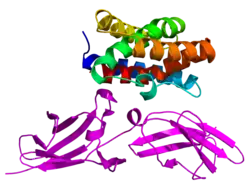 | |||||||||||||||||||||||||||||||||||||||||||||||||||
| |||||||||||||||||||||||||||||||||||||||||||||||||||
| Identifiers | |||||||||||||||||||||||||||||||||||||||||||||||||||
| Aliases | IL22, IL-21, IL-22, IL-D110, IL-TIF, ILTIF, TIFIL-23, TIFa, zcyto18, interleukin 22 | ||||||||||||||||||||||||||||||||||||||||||||||||||
| External IDs | OMIM: 605330 MGI: 2151139 HomoloGene: 9669 GeneCards: IL22 | ||||||||||||||||||||||||||||||||||||||||||||||||||
| |||||||||||||||||||||||||||||||||||||||||||||||||||
| |||||||||||||||||||||||||||||||||||||||||||||||||||
| |||||||||||||||||||||||||||||||||||||||||||||||||||
| |||||||||||||||||||||||||||||||||||||||||||||||||||
| |||||||||||||||||||||||||||||||||||||||||||||||||||
| Wikidata | |||||||||||||||||||||||||||||||||||||||||||||||||||
| |||||||||||||||||||||||||||||||||||||||||||||||||||
Interleukin-22 (IL-22) is protein that in humans is encoded by the IL22 gene.[5][6]
Structure
IL-22 is an α-helical cytokine. IL-22 binds to a heterodimeric cell surface receptor composed of IL-10R2 and IL-22R1 subunits.[7] IL-22R is expressed on tissue cells, and it is absent on immune cells.[8]
Crystallization is possible if the N-linked glycosylation sites are removed in mutants of IL-22 bound with high-affinity cell-surface receptor sIL-22R1. The crystallographic asymmetric unit contained two IL-22-sIL-22R1 complexes.[7]
Function
IL-22 is produced by several populations of immune cells at a site of inflammation. Producers are αβ T-cell classes Th1, Th22 and Th17 along with γδ T cells, NKT, ILC3, neutrophils and macrophages. IL-22 takes effect on non-hematopoietic cells – mainly stromal and epithelial cells. Effects involve stimulation of cell survival, proliferation and synthesis of antimicrobials including S100, Reg3β, Reg3γ and defensins. IL-22 thus participates in both wound healing and in protection against microbes.[9] IL-22 dysregulation takes part in pathogenesis of several autoimmune diseases like systemic lupus erythematosus, rheumatoid arthritis and psoriasis.[10]
IL-22 biological activity is initiated by binding to a cell-surface complex composed of IL-22R1 and IL-10R2 receptor chains and further regulated by interactions with a soluble binding protein, IL-22BP, which shares sequence similarity with an extracellular region of IL-22R1 (sIL-22R1). IL-22 and IL-10 receptor chains play a role in cellular targeting and signal transduction to selectively initiate and regulate immune responses.[7] IL-22 can contribute to immune disease through the stimulation of inflammatory responses, S100s and defensins. IL-22 also promotes hepatocyte survival in the liver and epithelial cells in the lung and gut similar to IL-10.[11] In some contexts, the pro-inflammatory versus tissue-protective functions of IL-22 are regulated by the often co-expressed cytokine IL-17A [12]
Target tissue
Targets of this cytokine are mostly non-hematopoietic cells – epithelial and stromal cells of following tissues and organs: liver, lung, skin, thymus, pancreas, kidney, gastrointestinal tract, synovial tissues, heart, breast, eye and adipose tissue.[9]
Signaling
IL-22 is a member of a group of cytokines called the IL-10 family or IL-10 superfamily (including IL-19, IL-20, IL-24, and IL-26),[13] a class of potent mediators of cellular inflammatory responses. It shares use of IL-10R2 in cell signaling with other members of this family, IL-10, IL-26, IL-28A/B and IL-29.[14]
IL-22, signals through the interferon receptor-related proteins CRF2-4 and IL-22R.[6] It forms cell surface complexes with IL-22R1 and IL-10R2 chains resulting in signal transduction through receptor, IL-10R2. The IL-22/IL-22R1/IL-10R2 complex activates intracellular kinases (JAK1, Tyk2, and MAP kinases) and transcription factors, especially STAT3. It can induce IL-20 and IL-24 signaling when IL-22R1 pairs with IL-20R2.
Regulation of production
IL-22 production is induced mainly through IL-23 receptor signalling. IL-23 is produced by dendritic cells after recognition of ligands by specific Toll-like receptors especially in combination with Dectin-1 and or NOD2 signalling. IL-1β stimulates IL-22 production too. On the other hand IL-22 binding protein is a soluble inhibitor which blocks receptor binding site of IL-22.[9]
References
- 1 2 3 GRCh38: Ensembl release 89: ENSG00000127318 - Ensembl, May 2017
- 1 2 3 GRCm38: Ensembl release 89: ENSMUSG00000090461 - Ensembl, May 2017
- ↑ "Human PubMed Reference:". National Center for Biotechnology Information, U.S. National Library of Medicine.
- ↑ "Mouse PubMed Reference:". National Center for Biotechnology Information, U.S. National Library of Medicine.
- ↑ Dumoutier L, Van Roost E, Colau D, Renauld JC (August 2000). "Human interleukin-10-related T cell-derived inducible factor: molecular cloning and functional characterization as an hepatocyte-stimulating factor". Proceedings of the National Academy of Sciences of the United States of America. 97 (18): 10144–9. Bibcode:2000PNAS...9710144D. doi:10.1073/pnas.170291697. PMC 27764. PMID 10954742.
- 1 2 Xie MH, Aggarwal S, Ho WH, Foster J, Zhang Z, Stinson J, et al. (October 2000). "Interleukin (IL)-22, a novel human cytokine that signals through the interferon receptor-related proteins CRF2-4 and IL-22R". The Journal of Biological Chemistry. 275 (40): 31335–9. doi:10.1074/jbc.M005304200. PMID 10875937.
- 1 2 3 PDB: 3DGC; Jones BC, Logsdon NJ, Walter MR (September 2008). "Structure of IL-22 bound to its high-affinity IL-22R1 chain". Structure. 16 (9): 1333–44. doi:10.1016/j.str.2008.06.005. PMC 2637415. PMID 18599299.
- ↑ Wolk K, Kunz S, Witte E, Friedrich M, Asadullah K, Sabat R (August 2004). "IL-22 increases the innate immunity of tissues". Immunity. 21 (2): 241–54. doi:10.1016/j.immuni.2004.07.007. PMID 15308104.
- 1 2 3 Dudakov JA, Hanash AM, van den Brink MR (2015-03-21). "Interleukin-22: immunobiology and pathology". Annual Review of Immunology. 33 (1): 747–85. doi:10.1146/annurev-immunol-032414-112123. PMC 4407497. PMID 25706098.
- ↑ Pan HF, Li XP, Zheng SG, Ye DQ (February 2013). "Emerging role of interleukin-22 in autoimmune diseases". Cytokine & Growth Factor Reviews. 24 (1): 51–7. doi:10.1016/j.cytogfr.2012.07.002. PMC 4003867. PMID 22906768.
- ↑ Moore KW, de Waal Malefyt R, Coffman RL, O'Garra A (2001). "Interleukin-10 and the interleukin-10 receptor". Annual Review of Immunology. 19: 683–765. doi:10.1146/annurev.immunol.19.1.683. PMID 11244051..
- ↑ Sonnenberg GF, Nair MG, Kirn TJ, Zaph C, Fouser LA, Artis D (June 2010). "Pathological versus protective functions of IL-22 in airway inflammation are regulated by IL-17A". The Journal of Experimental Medicine. 207 (6): 1293–305. doi:10.1084/jem.20092054. PMC 2882840. PMID 20498020.
- ↑ Pestka S, Krause CD, Sarkar D, Walter MR, Shi Y, Fisher PB (2004). "Interleukin-10 and related cytokines and receptors". Annual Review of Immunology. 22: 929–79. doi:10.1146/annurev.immunol.22.012703.104622. PMID 15032600.
- ↑ Witte K, Witte E, Sabat R, Wolk K (August 2010). "IL-28A, IL-28B, and IL-29: promising cytokines with type I interferon-like properties". Cytokine & Growth Factor Reviews. 21 (4): 237–51. doi:10.1016/j.cytogfr.2010.04.002. PMID 20655797.
Further reading
- Weger W, Hofer A, Wolf P, El-Shabrawi Y, Renner W, Kerl H, Salmhofer W (September 2009). "Common polymorphisms in the interleukin-22 gene are not associated with chronic plaque psoriasis". Experimental Dermatology. 18 (9): 796–8. doi:10.1111/j.1600-0625.2009.00840.x. PMID 19469905. S2CID 22906785.
- Davila S, Froeling FE, Tan A, Bonnard C, Boland GJ, Snippe H, et al. (April 2010). "New genetic associations detected in a host response study to hepatitis B vaccine". Genes and Immunity. 11 (3): 232–8. doi:10.1038/gene.2010.1. PMID 20237496.
- Silverberg MS, Cho JH, Rioux JD, McGovern DP, Wu J, Annese V, et al. (February 2009). "Ulcerative colitis-risk loci on chromosomes 1p36 and 12q15 found by genome-wide association study". Nature Genetics. 41 (2): 216–20. doi:10.1038/ng.275. PMC 2652837. PMID 19122664.
- de Moura PR, Watanabe L, Bleicher L, Colau D, Dumoutier L, Lemaire MM, et al. (April 2009). "Crystal structure of a soluble decoy receptor IL-22BP bound to interleukin-22". FEBS Letters. 583 (7): 1072–7. doi:10.1016/j.febslet.2009.03.006. PMID 19285080. S2CID 24846059.
- Wong CK, Lun SW, Ko FW, Wong PT, Hu SQ, Chan IH, et al. (2009). "Activation of peripheral Th17 lymphocytes in patients with asthma". Immunological Investigations. 38 (7): 652–64. doi:10.1080/08820130903062756. PMID 19811428. S2CID 36646289.
- Shen H, Goodall JC, Hill Gaston JS (June 2009). "Frequency and phenotype of peripheral blood Th17 cells in ankylosing spondylitis and rheumatoid arthritis". Arthritis and Rheumatism. 60 (6): 1647–56. doi:10.1002/art.24568. PMID 19479869.
- Thompson CL, Plummer SJ, Tucker TC, Casey G, Li L (August 2010). "Interleukin-22 genetic polymorphisms and risk of colon cancer". Cancer Causes & Control. 21 (8): 1165–70. doi:10.1007/s10552-010-9542-5. PMID 20339910. S2CID 22534683.
- Hughes T, Becknell B, McClory S, Briercheck E, Freud AG, Zhang X, et al. (April 2009). "Stage 3 immature human natural killer cells found in secondary lymphoid tissue constitutively and selectively express the TH 17 cytokine interleukin-22". Blood. 113 (17): 4008–10. doi:10.1182/blood-2008-12-192443. PMC 2673127. PMID 19244159.
- Siezen CL, Bont L, Hodemaekers HM, Ermers MJ, Doornbos G, Van't Slot R, et al. (April 2009). "Genetic susceptibility to respiratory syncytial virus bronchiolitis in preterm children is associated with airway remodeling genes and innate immune genes". The Pediatric Infectious Disease Journal. 28 (4): 333–5. doi:10.1097/INF.0b013e31818e2aa9. PMID 19258923. S2CID 25601837.
- Pitta MG, Romano A, Cabantous S, Henri S, Hammad A, Kouriba B, et al. (August 2009). "IL-17 and IL-22 are associated with protection against human kala azar caused by Leishmania donovani". The Journal of Clinical Investigation. 119 (8): 2379–87. doi:10.1172/JCI38813. PMC 2719936. PMID 19620772.
- Pan HF, Zhao XF, Yuan H, Zhang WH, Li XP, Wang GH, et al. (March 2009). "Decreased serum IL-22 levels in patients with systemic lupus erythematosus". Clinica Chimica Acta; International Journal of Clinical Chemistry. 401 (1–2): 179–80. doi:10.1016/j.cca.2008.11.009. PMID 19046958.
- Liu Y, Yang B, Zhou M, Li L, Zhou H, Zhang J, et al. (June 2009). "Memory IL-22-producing CD4+ T cells specific for Candida albicans are present in humans". European Journal of Immunology. 39 (6): 1472–9. doi:10.1002/eji.200838811. PMID 19449309.
- Sekikawa A, Fukui H, Suzuki K, Karibe T, Fujii S, Ichikawa K, et al. (March 2010). "Involvement of the IL-22/REG Ialpha axis in ulcerative colitis". Laboratory Investigation; A Journal of Technical Methods and Pathology. 90 (3): 496–505. doi:10.1038/labinvest.2009.147. PMID 20065946.
- He M, Liang P (February 2010). "IL-24 transgenic mice: in vivo evidence of overlapping functions for IL-20, IL-22, and IL-24 in the epidermis". Journal of Immunology. 184 (4): 1793–8. doi:10.4049/jimmunol.0901829. PMID 20061404.
- Wolk K, Witte E, Warszawska K, Schulze-Tanzil G, Witte K, Philipp S, et al. (December 2009). "The Th17 cytokine IL-22 induces IL-20 production in keratinocytes: a novel immunological cascade with potential relevance in psoriasis". European Journal of Immunology. 39 (12): 3570–81. doi:10.1002/eji.200939687. PMID 19830738.
- Eyerich S, Eyerich K, Pennino D, Carbone T, Nasorri F, Pallotta S, et al. (December 2009). "Th22 cells represent a distinct human T cell subset involved in epidermal immunity and remodeling". The Journal of Clinical Investigation. 119 (12): 3573–85. doi:10.1172/JCI40202. PMC 2786807. PMID 19920355.
- Dhiman R, Indramohan M, Barnes PF, Nayak RC, Paidipally P, Rao LV, Vankayalapati R (November 2009). "IL-22 produced by human NK cells inhibits growth of Mycobacterium tuberculosis by enhancing phagolysosomal fusion". Journal of Immunology. 183 (10): 6639–45. doi:10.4049/jimmunol.0902587. PMID 19864591.
- Cella M, Fuchs A, Vermi W, Facchetti F, Otero K, Lennerz JK, et al. (February 2009). "A human natural killer cell subset provides an innate source of IL-22 for mucosal immunity". Nature. 457 (7230): 722–5. Bibcode:2009Natur.457..722C. doi:10.1038/nature07537. PMC 3772687. PMID 18978771.
- Sanjabi S, Zenewicz LA, Kamanaka M, Flavell RA (August 2009). "Anti-inflammatory and pro-inflammatory roles of TGF-beta, IL-10, and IL-22 in immunity and autoimmunity". Current Opinion in Pharmacology. 9 (4): 447–53. doi:10.1016/j.coph.2009.04.008. PMC 2755239. PMID 19481975.
- Kagami S, Rizzo HL, Lee JJ, Koguchi Y, Blauvelt A (May 2010). "Circulating Th17, Th22, and Th1 cells are increased in psoriasis". The Journal of Investigative Dermatology. 130 (5): 1373–83. doi:10.1038/jid.2009.399. PMC 2892169. PMID 20032993.
